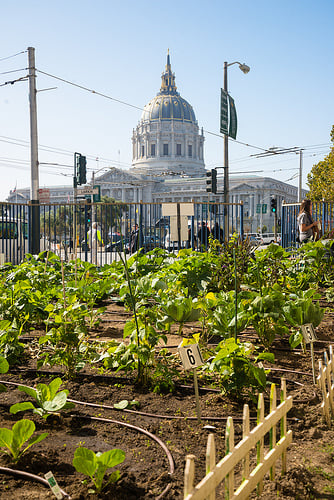Is urban agriculture worth the space?

From urbanists.
FastCo reports on Green Sense Farms, a warehouse outside of Chicago that produces soil-free produce to feed 20 million people, while urban farms are popping up from Cambridge, Massachusetts to Japan. The Ecologist encourages that “to reduce the pressure on the world’s productive land and to help assure long-term food security… city people are well advised to revive urban or peri-urban agriculture.” But just how efficient is urban agriculture?
Urban — also known as vertical — agriculture has a number of widely touted benefits: lowered transportation costs for food, as buyers tend to be local; reduced carbon footprint and decreased energy usage; potential job growth; an increased sense of local community; potentially improved nutrition, and, as National Geographic notes, even a boost in tourism, among other pro’s.
The practice isn’t new, nor is it confined to American foodies’ community gardens and reimagined rooftops. It’s been adapted in communities from Havana to Shanghai, accounts for producing 15% of the world’s food, and, as The Ecologist notes, based UNDP figures, around 800 million people were involved in urban agriculture globally in 1999; of these people, 200 million were considered market producers, and 150 million were employed full-time.
Proponents of urban farming like Robert Colangelo, president and founder of Green Sense Farms, say they want to grow “nutritious food in a new, sustainable way, and supplement field farms and greenhouses,” notes FastCo. They say that growing indoors, like Green Sense does, can also ensure crops against inclement weather, fungus, pests and other factors that trouble traditional farms.
But some of the problems that urban farming seeks to address — improved food distribution for certain communities, for one — aren’t easily solved by a patchwork of urban providers. FastCo recently reported on a mobile market that delivers food to a “food desert” community in Toronto, where residents have no access to fresh produce. While the market, housed on a bus, addresses the mobility and access problem, it is running into other challenges: It can’t fit many shoppers inside, and therefore can’t run in super-cold weather, and its timing is still being worked out so that more people are aware of it. (A better solution, says the organization’s director, are community-run food markets.)
Other cons associated with urban farming, especially in outdoor areas, include lack of space; expensive real estate; using untreated water than can lead to illness; a potential increase in urban pests; and decrease in nutritional value of food due to poor air quality in cities, among other factors. (Colangelo of Green Sense claims that his farm’s produce, which is grown indoors and under LED lights, is actually more nutritionally valuable than outdoor-grown produce, though this is not proven.)
Traditional farming remains the number-one method of food production. Without an overarching vision, the urban agriculture business poses inefficiency problems that may impact the existing system. As the National Resource Defense Council blogged, “it is critical that the farming support the urban aspects of the city instead of displacing them. This means the right kind of farming (e.g., vegetables, not sheep), at the right scale (small), and in the right spots (generally residential areas where other, more traditionally urban, uses are not displaced).” One key to integrating and developing urban agriculture to become an even more efficient means of food production will be for both rural and urban leaders to unite on common — if figurative — ground.
Want to learn more? Check out this interesting UC Davis report on the social, financial and health impact of urban agriculture.
Related Posts
Category: Miscellaneous

















